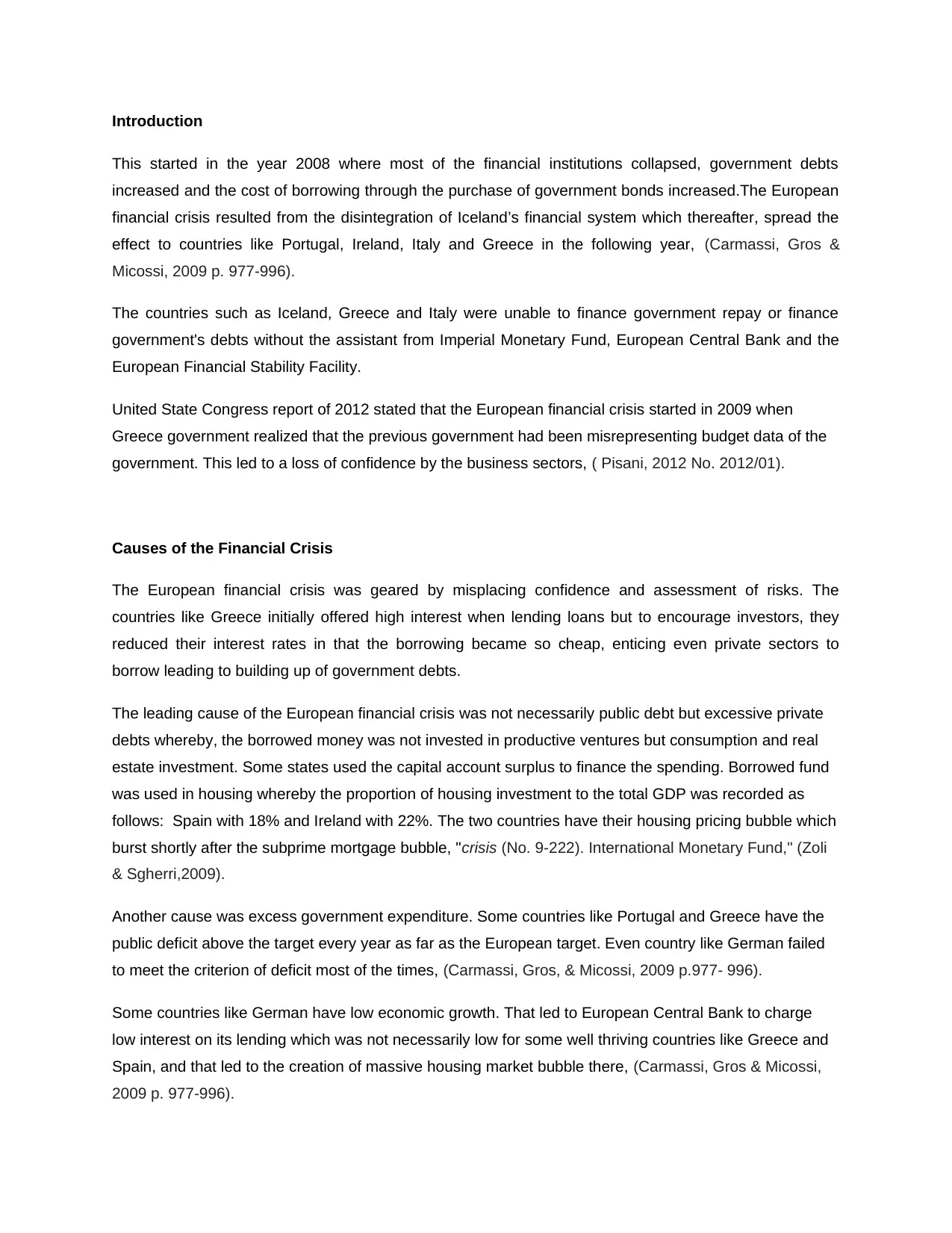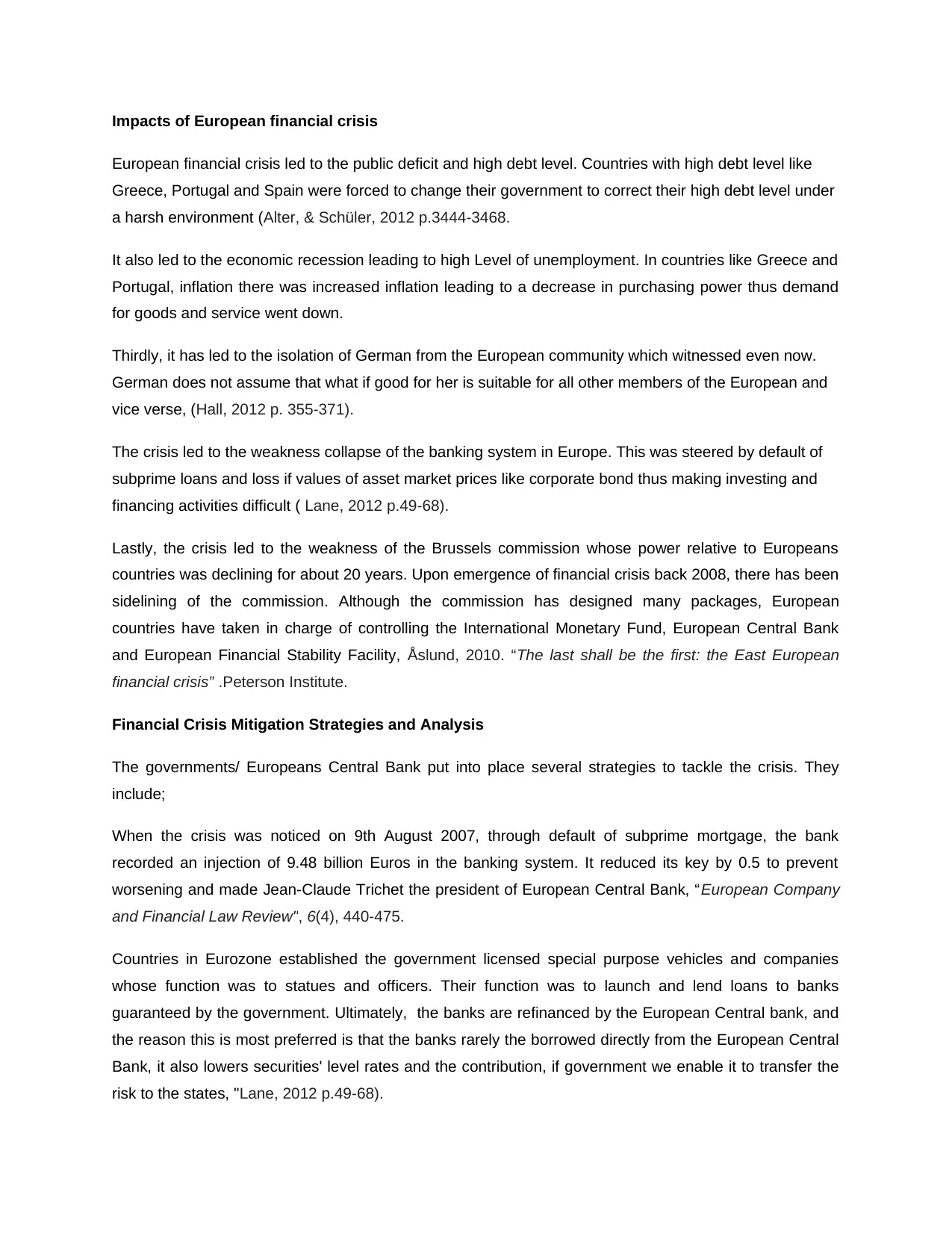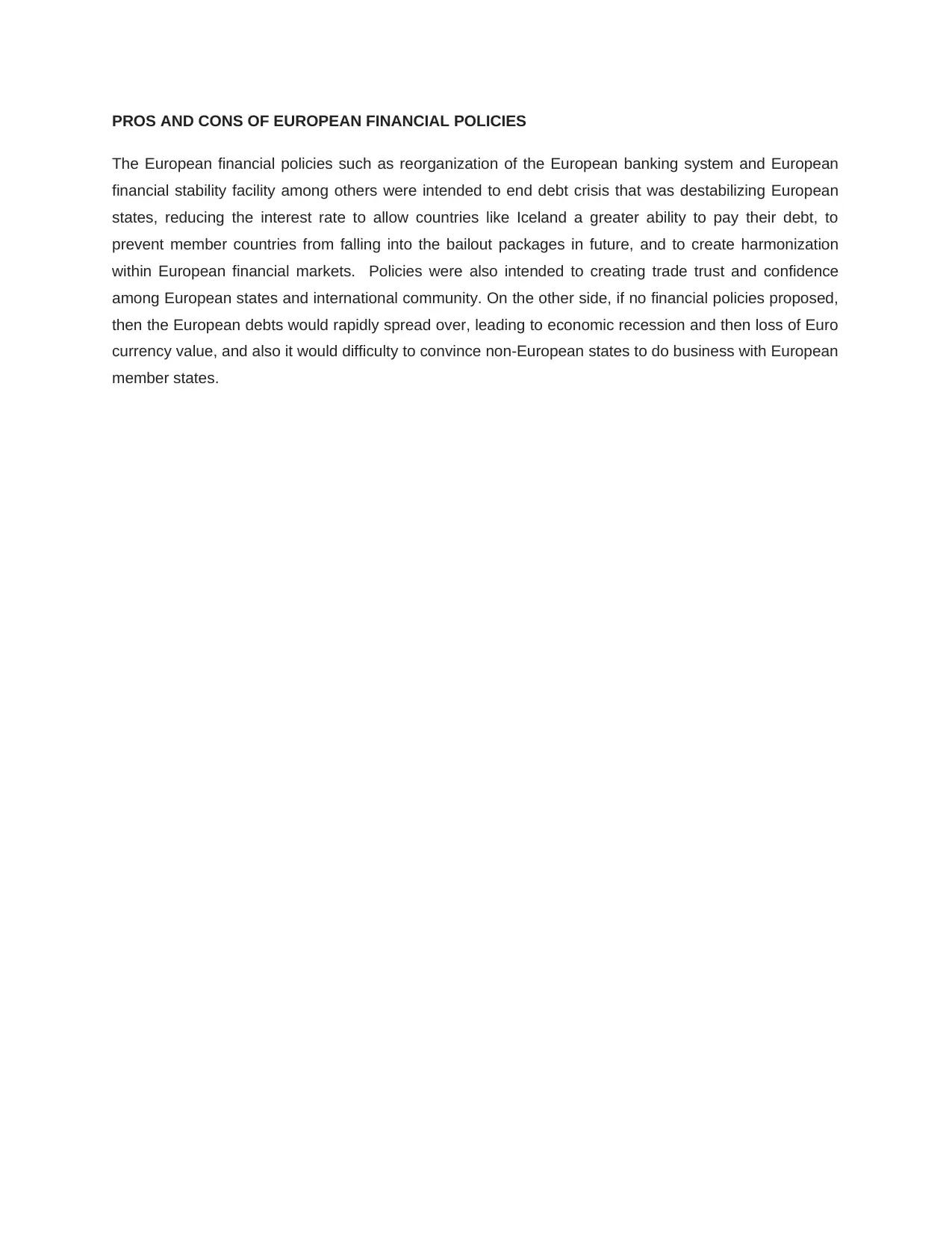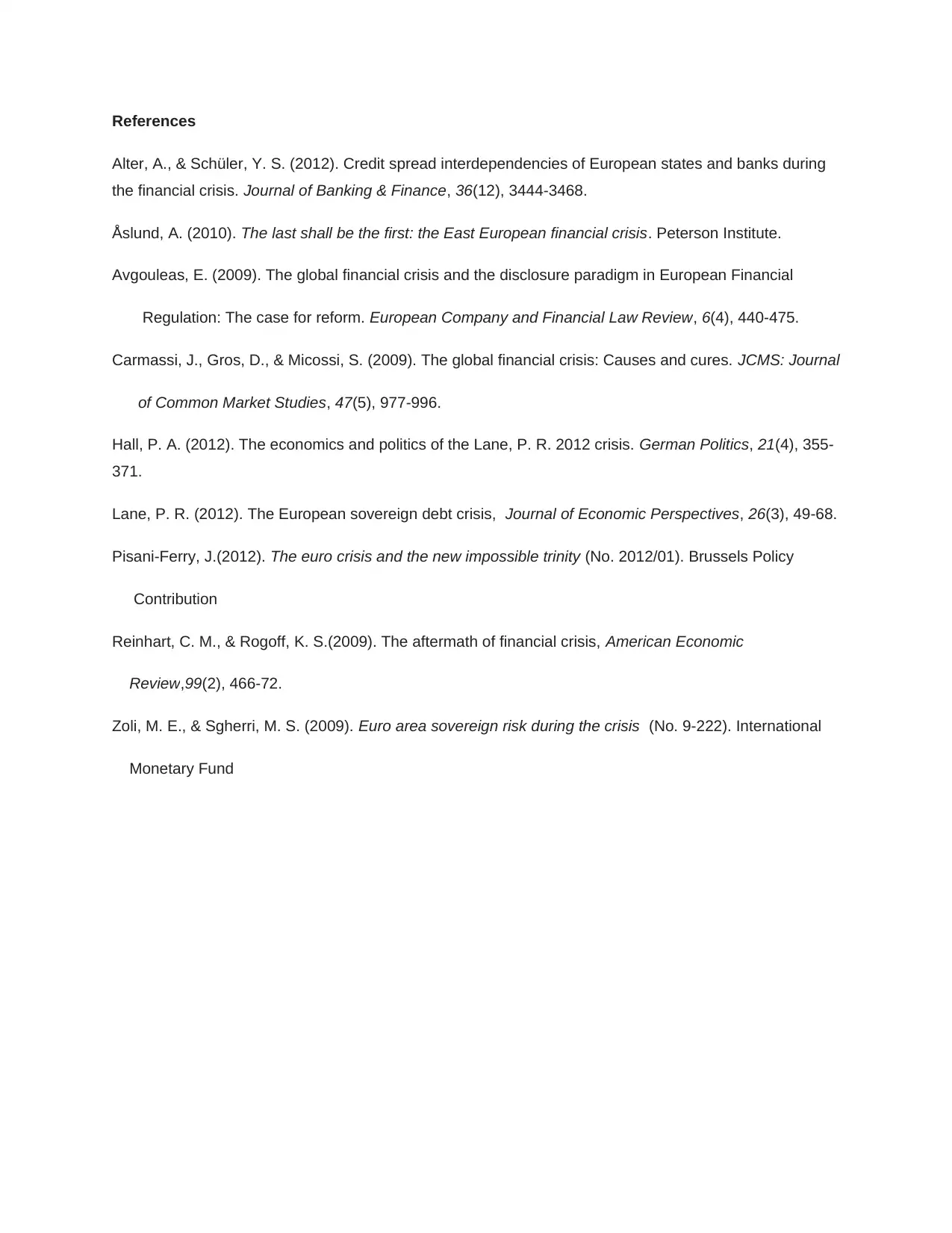Report: Analysis of the European Financial Crisis and Mitigation
VerifiedAdded on 2023/06/03
|6
|1521
|50
Report
AI Summary
This report provides a comprehensive analysis of the European Financial Crisis, beginning with its origins in 2008 and the subsequent spread to several European countries. The report delves into the causes, including excessive private and public debts, misallocation of resources, and low economic growth in certain countries. It explores the significant impacts, such as public deficits, economic recession, unemployment, and the weakening of the banking system. Furthermore, it examines the mitigation strategies employed, including financial injections, government-licensed special purpose vehicles, and reforms by international authorities. The report also discusses the pros and cons of the European policies implemented to address the crisis, offering a balanced perspective on their effectiveness. Finally, it concludes with a discussion on the importance of educating German nationals on the relevance of Europe.

EUROPEAN FINANCIAL CRISIS
(COURSE)
(STUDENT ID)
(SUBMISSION DATE)
(COURSE)
(STUDENT ID)
(SUBMISSION DATE)
Paraphrase This Document
Need a fresh take? Get an instant paraphrase of this document with our AI Paraphraser

Introduction
This started in the year 2008 where most of the financial institutions collapsed, government debts
increased and the cost of borrowing through the purchase of government bonds increased.The European
financial crisis resulted from the disintegration of Iceland’s financial system which thereafter, spread the
effect to countries like Portugal, Ireland, Italy and Greece in the following year, (Carmassi, Gros &
Micossi, 2009 p. 977-996).
The countries such as Iceland, Greece and Italy were unable to finance government repay or finance
government's debts without the assistant from Imperial Monetary Fund, European Central Bank and the
European Financial Stability Facility.
United State Congress report of 2012 stated that the European financial crisis started in 2009 when
Greece government realized that the previous government had been misrepresenting budget data of the
government. This led to a loss of confidence by the business sectors, ( Pisani, 2012 No. 2012/01).
Causes of the Financial Crisis
The European financial crisis was geared by misplacing confidence and assessment of risks. The
countries like Greece initially offered high interest when lending loans but to encourage investors, they
reduced their interest rates in that the borrowing became so cheap, enticing even private sectors to
borrow leading to building up of government debts.
The leading cause of the European financial crisis was not necessarily public debt but excessive private
debts whereby, the borrowed money was not invested in productive ventures but consumption and real
estate investment. Some states used the capital account surplus to finance the spending. Borrowed fund
was used in housing whereby the proportion of housing investment to the total GDP was recorded as
follows: Spain with 18% and Ireland with 22%. The two countries have their housing pricing bubble which
burst shortly after the subprime mortgage bubble, "crisis (No. 9-222). International Monetary Fund," (Zoli
& Sgherri,2009).
Another cause was excess government expenditure. Some countries like Portugal and Greece have the
public deficit above the target every year as far as the European target. Even country like German failed
to meet the criterion of deficit most of the times, (Carmassi, Gros, & Micossi, 2009 p.977- 996).
Some countries like German have low economic growth. That led to European Central Bank to charge
low interest on its lending which was not necessarily low for some well thriving countries like Greece and
Spain, and that led to the creation of massive housing market bubble there, (Carmassi, Gros & Micossi,
2009 p. 977-996).
This started in the year 2008 where most of the financial institutions collapsed, government debts
increased and the cost of borrowing through the purchase of government bonds increased.The European
financial crisis resulted from the disintegration of Iceland’s financial system which thereafter, spread the
effect to countries like Portugal, Ireland, Italy and Greece in the following year, (Carmassi, Gros &
Micossi, 2009 p. 977-996).
The countries such as Iceland, Greece and Italy were unable to finance government repay or finance
government's debts without the assistant from Imperial Monetary Fund, European Central Bank and the
European Financial Stability Facility.
United State Congress report of 2012 stated that the European financial crisis started in 2009 when
Greece government realized that the previous government had been misrepresenting budget data of the
government. This led to a loss of confidence by the business sectors, ( Pisani, 2012 No. 2012/01).
Causes of the Financial Crisis
The European financial crisis was geared by misplacing confidence and assessment of risks. The
countries like Greece initially offered high interest when lending loans but to encourage investors, they
reduced their interest rates in that the borrowing became so cheap, enticing even private sectors to
borrow leading to building up of government debts.
The leading cause of the European financial crisis was not necessarily public debt but excessive private
debts whereby, the borrowed money was not invested in productive ventures but consumption and real
estate investment. Some states used the capital account surplus to finance the spending. Borrowed fund
was used in housing whereby the proportion of housing investment to the total GDP was recorded as
follows: Spain with 18% and Ireland with 22%. The two countries have their housing pricing bubble which
burst shortly after the subprime mortgage bubble, "crisis (No. 9-222). International Monetary Fund," (Zoli
& Sgherri,2009).
Another cause was excess government expenditure. Some countries like Portugal and Greece have the
public deficit above the target every year as far as the European target. Even country like German failed
to meet the criterion of deficit most of the times, (Carmassi, Gros, & Micossi, 2009 p.977- 996).
Some countries like German have low economic growth. That led to European Central Bank to charge
low interest on its lending which was not necessarily low for some well thriving countries like Greece and
Spain, and that led to the creation of massive housing market bubble there, (Carmassi, Gros & Micossi,
2009 p. 977-996).

Impacts of European financial crisis
European financial crisis led to the public deficit and high debt level. Countries with high debt level like
Greece, Portugal and Spain were forced to change their government to correct their high debt level under
a harsh environment (Alter, & Schüler, 2012 p.3444-3468.
It also led to the economic recession leading to high Level of unemployment. In countries like Greece and
Portugal, inflation there was increased inflation leading to a decrease in purchasing power thus demand
for goods and service went down.
Thirdly, it has led to the isolation of German from the European community which witnessed even now.
German does not assume that what if good for her is suitable for all other members of the European and
vice verse, (Hall, 2012 p. 355-371).
The crisis led to the weakness collapse of the banking system in Europe. This was steered by default of
subprime loans and loss if values of asset market prices like corporate bond thus making investing and
financing activities difficult ( Lane, 2012 p.49-68).
Lastly, the crisis led to the weakness of the Brussels commission whose power relative to Europeans
countries was declining for about 20 years. Upon emergence of financial crisis back 2008, there has been
sidelining of the commission. Although the commission has designed many packages, European
countries have taken in charge of controlling the International Monetary Fund, European Central Bank
and European Financial Stability Facility, Åslund, 2010. “The last shall be the first: the East European
financial crisis” .Peterson Institute.
Financial Crisis Mitigation Strategies and Analysis
The governments/ Europeans Central Bank put into place several strategies to tackle the crisis. They
include;
When the crisis was noticed on 9th August 2007, through default of subprime mortgage, the bank
recorded an injection of 9.48 billion Euros in the banking system. It reduced its key by 0.5 to prevent
worsening and made Jean-Claude Trichet the president of European Central Bank, “European Company
and Financial Law Review", 6(4), 440-475.
Countries in Eurozone established the government licensed special purpose vehicles and companies
whose function was to statues and officers. Their function was to launch and lend loans to banks
guaranteed by the government. Ultimately, the banks are refinanced by the European Central bank, and
the reason this is most preferred is that the banks rarely the borrowed directly from the European Central
Bank, it also lowers securities' level rates and the contribution, if government we enable it to transfer the
risk to the states, "Lane, 2012 p.49-68).
European financial crisis led to the public deficit and high debt level. Countries with high debt level like
Greece, Portugal and Spain were forced to change their government to correct their high debt level under
a harsh environment (Alter, & Schüler, 2012 p.3444-3468.
It also led to the economic recession leading to high Level of unemployment. In countries like Greece and
Portugal, inflation there was increased inflation leading to a decrease in purchasing power thus demand
for goods and service went down.
Thirdly, it has led to the isolation of German from the European community which witnessed even now.
German does not assume that what if good for her is suitable for all other members of the European and
vice verse, (Hall, 2012 p. 355-371).
The crisis led to the weakness collapse of the banking system in Europe. This was steered by default of
subprime loans and loss if values of asset market prices like corporate bond thus making investing and
financing activities difficult ( Lane, 2012 p.49-68).
Lastly, the crisis led to the weakness of the Brussels commission whose power relative to Europeans
countries was declining for about 20 years. Upon emergence of financial crisis back 2008, there has been
sidelining of the commission. Although the commission has designed many packages, European
countries have taken in charge of controlling the International Monetary Fund, European Central Bank
and European Financial Stability Facility, Åslund, 2010. “The last shall be the first: the East European
financial crisis” .Peterson Institute.
Financial Crisis Mitigation Strategies and Analysis
The governments/ Europeans Central Bank put into place several strategies to tackle the crisis. They
include;
When the crisis was noticed on 9th August 2007, through default of subprime mortgage, the bank
recorded an injection of 9.48 billion Euros in the banking system. It reduced its key by 0.5 to prevent
worsening and made Jean-Claude Trichet the president of European Central Bank, “European Company
and Financial Law Review", 6(4), 440-475.
Countries in Eurozone established the government licensed special purpose vehicles and companies
whose function was to statues and officers. Their function was to launch and lend loans to banks
guaranteed by the government. Ultimately, the banks are refinanced by the European Central bank, and
the reason this is most preferred is that the banks rarely the borrowed directly from the European Central
Bank, it also lowers securities' level rates and the contribution, if government we enable it to transfer the
risk to the states, "Lane, 2012 p.49-68).
⊘ This is a preview!⊘
Do you want full access?
Subscribe today to unlock all pages.

Trusted by 1+ million students worldwide

International authorities like the International Monetary Fund and national authorities formulated reform to
respond to the situation. Such reform can be summarized in as "more transparency more regulating,
more competing ". More transparency in financial information to avoid reduced confidence and
uncertainty, more regulating to ensure that the financial actors are working in line with financial stability
and more competing in that the financial information is accurate and not biased.The policy of educating
Germany on the importance of the Euro ZoneGerman nationals need to be educated thereon the
relevance of Europe, (Pisani- Ferry, 2012 No. 2012/01).
Note, the diagram below show European state debt roll-over and the public debt held against GDP.
The above data diagram can be accessed via; https://en.wikipedia.org/wiki/European_debt_crisis
Pros and Con of European Policies
respond to the situation. Such reform can be summarized in as "more transparency more regulating,
more competing ". More transparency in financial information to avoid reduced confidence and
uncertainty, more regulating to ensure that the financial actors are working in line with financial stability
and more competing in that the financial information is accurate and not biased.The policy of educating
Germany on the importance of the Euro ZoneGerman nationals need to be educated thereon the
relevance of Europe, (Pisani- Ferry, 2012 No. 2012/01).
Note, the diagram below show European state debt roll-over and the public debt held against GDP.
The above data diagram can be accessed via; https://en.wikipedia.org/wiki/European_debt_crisis
Pros and Con of European Policies
Paraphrase This Document
Need a fresh take? Get an instant paraphrase of this document with our AI Paraphraser

PROS AND CONS OF EUROPEAN FINANCIAL POLICIES
The European financial policies such as reorganization of the European banking system and European
financial stability facility among others were intended to end debt crisis that was destabilizing European
states, reducing the interest rate to allow countries like Iceland a greater ability to pay their debt, to
prevent member countries from falling into the bailout packages in future, and to create harmonization
within European financial markets. Policies were also intended to creating trade trust and confidence
among European states and international community. On the other side, if no financial policies proposed,
then the European debts would rapidly spread over, leading to economic recession and then loss of Euro
currency value, and also it would difficulty to convince non-European states to do business with European
member states.
The European financial policies such as reorganization of the European banking system and European
financial stability facility among others were intended to end debt crisis that was destabilizing European
states, reducing the interest rate to allow countries like Iceland a greater ability to pay their debt, to
prevent member countries from falling into the bailout packages in future, and to create harmonization
within European financial markets. Policies were also intended to creating trade trust and confidence
among European states and international community. On the other side, if no financial policies proposed,
then the European debts would rapidly spread over, leading to economic recession and then loss of Euro
currency value, and also it would difficulty to convince non-European states to do business with European
member states.

References
Alter, A., & Schüler, Y. S. (2012). Credit spread interdependencies of European states and banks during
the financial crisis. Journal of Banking & Finance, 36(12), 3444-3468.
Åslund, A. (2010). The last shall be the first: the East European financial crisis. Peterson Institute.
Avgouleas, E. (2009). The global financial crisis and the disclosure paradigm in European Financial
Regulation: The case for reform. European Company and Financial Law Review, 6(4), 440-475.
Carmassi, J., Gros, D., & Micossi, S. (2009). The global financial crisis: Causes and cures. JCMS: Journal
of Common Market Studies, 47(5), 977-996.
Hall, P. A. (2012). The economics and politics of the Lane, P. R. 2012 crisis. German Politics, 21(4), 355-
371.
Lane, P. R. (2012). The European sovereign debt crisis, Journal of Economic Perspectives, 26(3), 49-68.
Pisani-Ferry, J.(2012). The euro crisis and the new impossible trinity (No. 2012/01). Brussels Policy
Contribution
Reinhart, C. M., & Rogoff, K. S.(2009). The aftermath of financial crisis, American Economic
Review,99(2), 466-72.
Zoli, M. E., & Sgherri, M. S. (2009). Euro area sovereign risk during the crisis (No. 9-222). International
Monetary Fund
Alter, A., & Schüler, Y. S. (2012). Credit spread interdependencies of European states and banks during
the financial crisis. Journal of Banking & Finance, 36(12), 3444-3468.
Åslund, A. (2010). The last shall be the first: the East European financial crisis. Peterson Institute.
Avgouleas, E. (2009). The global financial crisis and the disclosure paradigm in European Financial
Regulation: The case for reform. European Company and Financial Law Review, 6(4), 440-475.
Carmassi, J., Gros, D., & Micossi, S. (2009). The global financial crisis: Causes and cures. JCMS: Journal
of Common Market Studies, 47(5), 977-996.
Hall, P. A. (2012). The economics and politics of the Lane, P. R. 2012 crisis. German Politics, 21(4), 355-
371.
Lane, P. R. (2012). The European sovereign debt crisis, Journal of Economic Perspectives, 26(3), 49-68.
Pisani-Ferry, J.(2012). The euro crisis and the new impossible trinity (No. 2012/01). Brussels Policy
Contribution
Reinhart, C. M., & Rogoff, K. S.(2009). The aftermath of financial crisis, American Economic
Review,99(2), 466-72.
Zoli, M. E., & Sgherri, M. S. (2009). Euro area sovereign risk during the crisis (No. 9-222). International
Monetary Fund
⊘ This is a preview!⊘
Do you want full access?
Subscribe today to unlock all pages.

Trusted by 1+ million students worldwide
1 out of 6
Related Documents
Your All-in-One AI-Powered Toolkit for Academic Success.
+13062052269
info@desklib.com
Available 24*7 on WhatsApp / Email
![[object Object]](/_next/static/media/star-bottom.7253800d.svg)
Unlock your academic potential
Copyright © 2020–2026 A2Z Services. All Rights Reserved. Developed and managed by ZUCOL.





